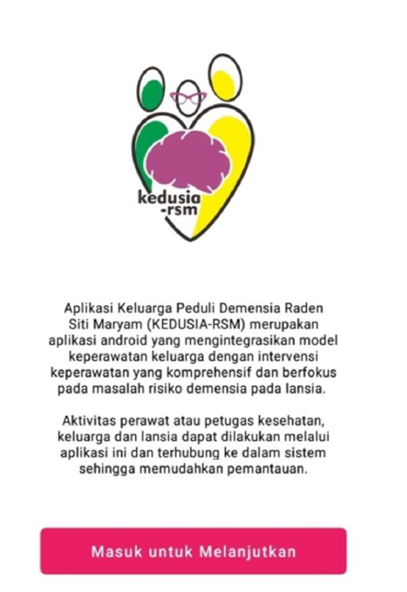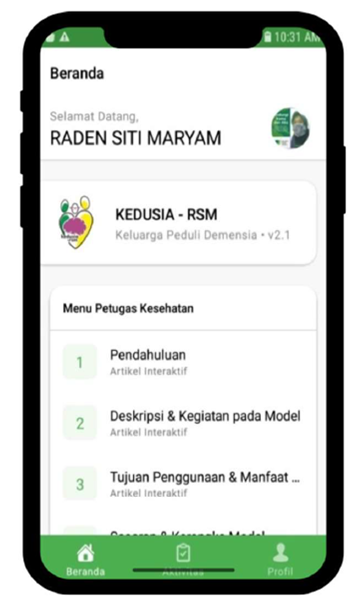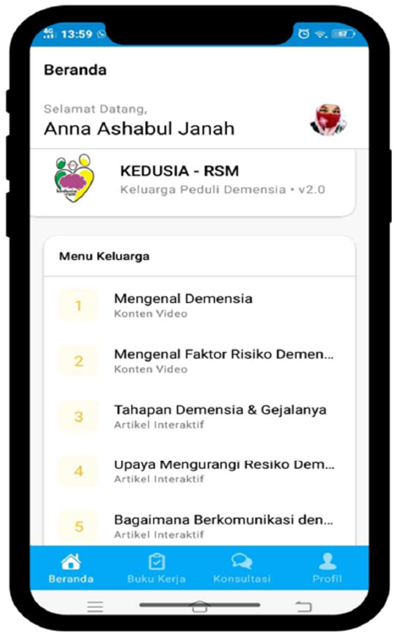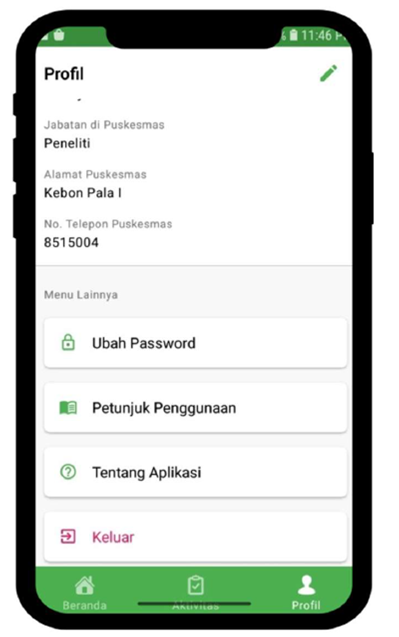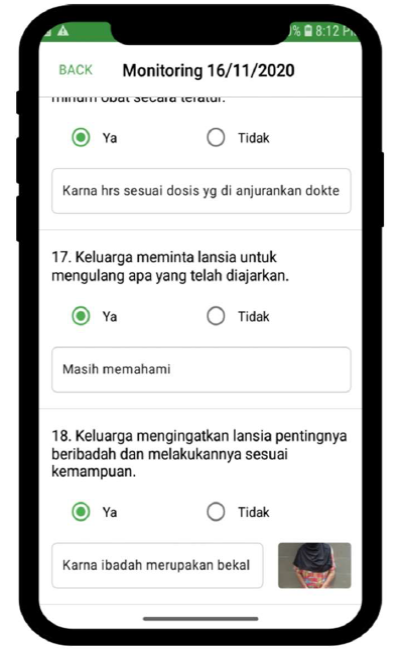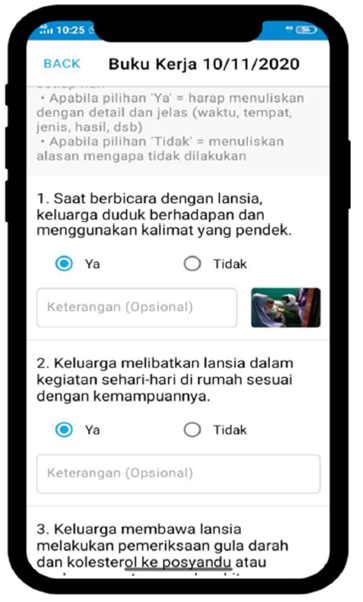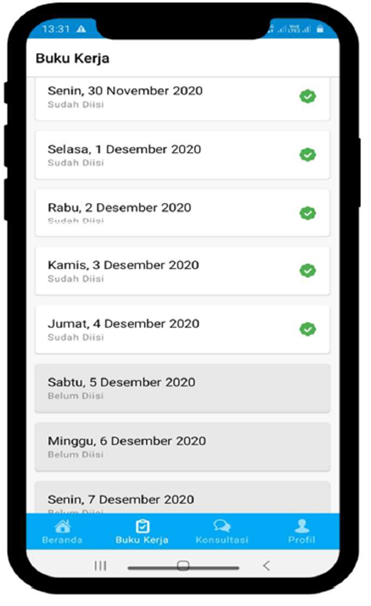Meu SciELO
Serviços Personalizados
Journal
Artigo
Indicadores
-
 Citado por SciELO
Citado por SciELO -
 Acessos
Acessos
Links relacionados
-
 Citado por Google
Citado por Google -
 Similares em
SciELO
Similares em
SciELO -
 Similares em Google
Similares em Google
Compartilhar
Enfermería Global
versão On-line ISSN 1695-6141
Enferm. glob. vol.22 no.72 Murcia Out. 2023 Epub 04-Dez-2023
https://dx.doi.org/10.6018/eglobal.557881
Originals
KEDUSIA-RSM: an Android-based nursing model for dementia prevention and better cognitive function in older adults
1Health Polytechnic Jakarta III, Jawa Barat, Indonesia
2Faculty of Nursing, Universitas Indonesia - Jawa Barat, Indonesia
3Faculty of Medicine, Universitas Indonesia - Jawa Barat, Indonesia
4Faculty of Public Health, Universitas Indonesia - Jawa Barat, Indonesia
Introduction:
Elderly people with dementia can become a burden to their family. Knowledge of the risk factors for dementia may lower the negative effects of dementia itself. Using Android-based applications can be helpful to families in preventing dementia and caring for the elderly.
Objective:
This study aimed to formulate an effective family nursing model through an Android-based application, Keluarga Peduli Demensia - Raden Siti Maryam (KEDUSIA-RSM), to enhance cognitive function and to monitor the risk factors of dementia in the elderly.
Methods:
This study employed an operational research design in two stages: 1) model development, integrating the study background, literature review, and expert consultation, and 2) model trials comparing pre- and post-test groups to control group. The sampling technique used was composite clustering sampling with the results of 156 samples: 79 families in the intervention group and 77 families in the control group.
Results:
The first stage resulted in the creation of two of the main components of the KEDUSIA-RSM nursing model: the guidebook and its android-based application; There were significant mean differences in cognitive function and dementia risk factor management between those groups before and four months after intervention model (p value < 0.05).
Conclusion:
KEDUSIA-RSM is proven to be effective in raising cognitive function and managing risk factors for dementia in the elderly. It is highly recommended to replicate the model, to conduct sustainable training for nurses within the community health field and to develop another study on an iOS-based or web-based app with a similar model.
Keywords: android-based application; cognitive function; KEDUSIA-RSM; nursing model; risk factors of dementia
INTRODUCTION
Dementia can be characterized as a set of cognitive impairment symptoms that deteriorate cognitive function continuously and progressively, such as memory loss, communication skill loss, intellectual decline, and other brain dysfunctions. These symptoms can disturb patients’ daily lives. Generally, dementia is followed by withdrawal from other aspects of life, such as social aspects, as people with dementia cannot comprehend other people’s feelings, and psychological and behavioural aspects, as patients can have difficulty concentrating or doing activities independently(1,2,3,4).
There were approximately 46.8 million people with dementia around the globe in 2015, and this number is expected to increase to 74.7 million by 2030 and 131.5 million by 2050. It is estimated that every 3.2 seconds, a new case of dementia occurs, for a total of around 9.9 million cases every year. The distribution of new cases of dementia per year in each region is 4.9 million in Asia, 2.5 million in Europe, 1.7 million in America and 0.8 million in Africa(5). In Indonesia, the number of dementia cases in 2015 reached 1.2 million people and will reach 1.9 million in 2030 and 4 million in 2050(2,6). These estimates show that dementia is a major concern for health workers and the community.
Research showed that 341 elderly people in Greater Jakarta suffered from cognitive impairment of 91.8% according to the Clock Drawing Test(7). The research also showed that female gender and poor education are correlated with cognitive impairment. Elderly people with dementia will experience gradual cognitive impairment and other functional decline, which can interfere with daily life, so they will be highly dependent on their family members. The burden of caring for patients with dementia often comes with a high risk of stress. Symptoms such as memory loss (42.4%) should receive more attention from patients’ families alongside other symptoms because it is progressive and can interfere with daily activities(8). These data should be a concern for all of us to take steps together. In line with states that early detection and diagnosis of dementia are crucial as the elderly population continues to grow(9,10,11). Therefore, efforts are also needed to prevent and manage the risk factors for dementia in the community.
Brain exercise for the elderly is one way to prevent and manage dementia. It is preferable to carry out such exercises, which include physical, mental and social stimulation activities, in groups rather than alone, and the use of brain exercise more effective than relying solely on medicines(12,13). Research by(14) found that memory training could help the elderly improve their memory.
In addition to brain exercise, informational support, such as health education, can be helpful. Informational support has been rapidly developed in recent years, changing the face of digital health information and people’s behaviour in seeking health information. In the current state of the COVID-19 pandemic, many people can access mobile learning through mobile applications, which facilitate the access and delivery of information(15,16). The number of smartphone users in Indonesia become the 5th largest in the world and is expected to reach more than 100 million people, so it is hoped that the implementation of educational methods through the use of applications will be more effective than the print media that have been used thus far(16-17,18). Mobile devices that run applications, such as social media, can be adapted to support the care of people with dementia(19).
The results of a survey completed by 30 families in region Kampung Melayu East Jakarta revealed that most of the families use smartphones and have designated funds to buy data packages (96.7%). Most of the applications already installed on their smartphones related to religion (41.4%), education and transportation (31.0%) and games (24.1%). Health and wellness applications were installed by only around 6.9% of respondents, although most families stated that such applications are very important (63.3%). The reasons families gave for opening an application were curiosity (86.2%), simpler than books (44.8%), more interesting and easy to read (27.6%), health problems that need to be understood (17.2%) and more pleasure (13.8%). These results illustrate that smartphones are among the gadgets that can be used in general. The COVID-19 pandemic situation has encouraged caregivers to use digital technology to improve self-care management, social participation and mild cognitive impairment (MCI) among the elderly with dementia(20). The use of digital gaming technology can enhance lifelong learning and optimize cognitive, physical, social and independent stimulation, all of which can lead to healthy ageing(21).
Several intervention models related to dementia care have been carried out, including a mobile application called Cardiovascular Risk Factors, Aging, and Incidence of Dementia (CAIDE) that aims to facilitate the detection of risk factors for dementia. Several models of nursing intervention with a family approach, especially in the elderly with non-communicable diseases, have been previously studied in Indonesia, including a Sundanese culture-sensitive family nursing model effective in increasing family knowledge and reducing blood sugar levels in the elderly with diabetes(22). A model developed with focuses on family support intervention for the elderly with hypertension(23). Finally, an independent family group model was designed to integrate self-help groups and support groups for the elderly, improving their health status and quality of life ((24). However, some of these models focus only on one health problem in the elderly and have not yet been upgraded to a technological medium of providing health information.
“Keluarga Peduli Demensia - Raden Siti Maryam (KEDUSIA-RSM)” nursing model emphasizes family nursing care and community empowerment to prevent and manage the risk factors for dementia in the elderly through an android-based application, which has not yet been implemented in other research within the field. The family is the core of the support system in this model, in addition to the active involvement of the elderly themselves and the role of health workers in the community health-center. This model aims to prevent and manage risk factors for dementia in the elderly through an application-based educational approach that is easy for families to use and easy for health workers to monitor and evaluate. The author found no existing study on dementia prevention care programmes based on android applications, so the development of this nursing model can assist families in caring for the elderly at risk of dementia.
METHODOLOGY
Quasi-experimental research was implemented in this study with a non-equivalent control-group pre-test post-test design. The population in this study was selected based on the results of a preliminary study, which included families residing in five areas within Greater Jakarta and living with elderly people susceptible to dementia. The criteria of family were to live with the elderly, be a caregiver for elderly, participate in the study and sign an informed consent form, have or use an android-based smartphone on a daily basis and be capable of reading, writing and available to answer the researchers’ messages. The elderly susceptible to dementia were selected according to the following inclusion criteria were to be aged 60 or over, live with their family, have been exposed to at least two risk factors (hypertension, diabetes mellitus, obesity and hypercholesterolemia) and be able to communicate. The exclusion criteria were hearing loss in both ears, failure to take the post test and having died. The sample size in this study was 84 for the intervention group and 84 for the control group, for a total of 168 families with elderly members at risk of dementia. Bivariate analysis was conducted to determine the difference in the mean score for cognitive function and dementia risk factor management between the elderly in the intervention group and the control group using the unpaired t-test. Hopkins Verbal Learning Test (HVLT) instrument used to screening dementia with Alpha Cronbach 0.850.
This research was approved by the Ethics Committee of the Faculty of Nursing, Universitas Indonesia, with the number SK-261/UN2.F12.D1.2.1/ETIK.FIK.2019. This study began with an explanation of the objectives, and voluntary consent was obtained from the respondents, as proven by the signed informed consent forms. All data were kept confidential and will be used for future research.
RESULTS
KEDUSIA-RSM offers three roles for users, namely nurses or health workers, family members and the elderly. Nurses and family users are given different usernames and passwords to log in. This application is equipped with a change-password menu, application usage guide and information about the application in the usage guide. Nurse users can log in and view profile data and staff menus related to model explanations. The family and elderly menus include health education materials in the form of interactive videos about dementia, risk factors for dementia, prevention efforts and dementia prevention skills carried out by the family; education materials in the form of interactive articles about the stages and symptoms of dementia, communication with the elderly experiencing cognitive decline and cognitive stimulation in the elderly; and a guessing game of pictures, colours and letters (see Figure 1, 2, 6). The games in the application are only one part of the cognitive stimulation activities that the elderly can do with their family.
Nurse users can monitor the activities/ workbooks are understood to be included in the proposed application related to daily activities that families carry out in providing care to their elderly, can monitor what menus are opened or read by the family and can make direct contact via telephone and whatsapp menus inside the application (see Figure 2, 3, 5)
As users, families and the elderly can log in from several cell phones to enable all family members to open menus containing education related to dementia risk factors and skills that families can perform for their elderly (see Figure 6). Responsible family members and elderly users have profiles containing their demographic data that can be changed and to which personal photos can be added (see Figure 4). The workbook menu in the application must be filled in by the family regarding their skills in caring for the elderly at risk of dementia. It is possible to attach photos of activities with the elderly, of medical cards and of skills that must be learned by the family to this workbook (see Figure 7-8). This Android-based KEDUSIA-RSM application has received Intellectual Property Right (IPR) from Ministry of Law and Human Rights in the form of a certificate for this type of computer programme. The visual appearance of the android application is shown in the Figure below.
The cognitive function of the elderly participants was measured using the Hopkins Verbal Learning Test (HVLT) before the model was introduced to both groups. Table 1 shows the results of cognitive function measurement.
Table 1. The distribution of cognitive function in the elderly in control and intervention groups according to HVLT measurements Greater Jakarta, 2020.

In this study, a combination of eight risk factors for dementia in the elderly were managed. Differences in these factors between the two groups could be measured by homogeneity test were diabetes, cholesterolemia, obesity, depression, physical activity, social activity, cognitive stimulation and head injury. The following is an overview of the variables for dementia risk factors before exposure to the intervention. Table 2 below shows the result of distribution risk factor management.
Table 2. The distribution of dementia risk factor management in the elderly in control and intervention groups, Greater Jakarta, 2020.

Table 3 shows the increase in the average cognitive function of the elderly before the model intervention and four months after the model intervention. The difference in the mean cognitive function score after a 4-month intervention in the intervention group was 6.19, which was greater than in the control group (1.51).
Table 3. The mean score distribution of cognitive function of the elderly in the control and intervention groups before and after 4 months of KEDUSIA-RM exposure, Greater Jakarta, 2020.

Table 4 shows the increase in the mean measurement of dementia risk factor management in the elderly in the intervention group and the control group before the model intervention and after 4 months of model intervention. The average difference in controlling dementia risk factors in the intervention group was 1.35, which was greater than in the control group (0.35).
DISCUSSION
The KEDUSIA-RSM is different from other models with a similar focus, such as the CAIDE(25), the reflective learning model(19) and the Arbi care model(26). The different showed in approach of KEDUSIA-RSM that focuses on family nursing care for the elderly susceptible to dementia. The roles of the family as the main caregivers, the nurses and the elderly are all connected in one application. Health information related to managing risk factors for dementia can be accessed by users, and the elderly can play games for cognitive stimulation. Nurses and community health volunteers can give their assistance for usage guide application through home visits. Also, a digital questionnaire for dementia prevention’s skill is provided within the application for families to fill in, all activities of the elder adults and caregivers can be monitored directly by the nurse. This model is proven to be effective in managing risk factors for dementia in the elderly.
Efforts to manage non-communicable diseases were carried out through the implementation of the KEDUSIA-RSM family nursing model in families that take care of elderly family members susceptible to dementia. This model of intervention was conducted during the COVID-19 pandemic, which required the implementation of the approach to be modified in compliance with health protocols. The elderly have been one of the most vulnerable groups during the pandemic because they are highly susceptible to infection with COVID-19(27-29). This vulnerability in the elderly requires a high degree of attention from all of us, especially families and the surrounding community, to reduce their risk of infection with COVID-19.
A significant increase in the average cognitive function of the elderly was observed between the intervention and control groups after 4 months of model intervention exposure. This was indicated by the increased mean score of cognitive function in the elderly in the intervention group compared to the control group. The intervention of the KEDUSIA-RSM model shows that performing nursing interventions on the elderly susceptible to dementia, including health education activities, exercises to maintain a healthy lifestyle, cognitive stimulation, mentoring and home visit, as well as providing motivation to families and the elderly, can improve their cognitive function. According to research, having a healthy lifestyle and being physically active can benefit elderly people with decreasing health status and cognitive impairment(30).
To support the cognitive function result, most of the elderly from intervention and control groups could perform some basic daily activities (BADL) independently, such as bathing, getting dressed, eating, walking and going to the toilet, after being exposed to this intervention model. Additional activities (IADL), such as using the telephone, shopping, preparing food, doing daily chores, using transportation, taking medicine and doing basic household financial management, could be done independently in both groups. Therefore, carrying out routine activities is expected to prevent a decline in cognitive function in the elderly. These activities may have contributed to both groups’ ability to perform activities of daily life such as doing regular exercise three times a week for a duration of 10-15 minutes; social activities in the community, such as gatherings and holy Qur’an recitations; and mental activities (brain stimulation), such as crossword puzzles, playing chess, counting and singing(7). Physical activity for the elderly is diverse and can be adapted to their preferences and abilities(1,2,11).
There was a significant difference in the mean score of dementia risk factor management between the intervention and control groups after four months of intervention, with a higher score in the intervention group than in the control group. The intervention group was exposed to essential knowledge for managing dementia risk factors. The dementia risk factors managed in this study were body weight, blood sugar levels, cholesterol levels, blood pressure, depression, smoking habits, hearing loss, history of head injury, exercise, social activities and cognitive stimulation. Controlling of dementia risk factors must be considered for families who care for the elderly(1,2,6,23).
Physical exercises, such as gymnastics, cycling and leisure walking, can also be done by the elderly to benefit their physical condition, while a lack of physical activity can increase the risk of dementia. This is supported by the results of research(30), who found that a physically active and healthy lifestyle has a beneficial effect in people of old age, who experience gradually decreasing physical function and cognitive impairment.
Participating families obtained knowledge related to risk factors for dementia through health education materials from android applications in the form of videos, articles and games (Figure 6). Families’ attitudes towards and skills in providing care for the elderly could be observed by researchers and nurses when carrying out health checks, monitored and strengthened during home visits and communicated directly through video calls. Skill activities carried out by families for the benefit of the elderly are provided in workbooks in the android app and can be monitored directly by researchers (Figure 5, 7). Skills carried out by the family include keeping the elderly person active and productive by supporting them in completing daily activities, social and community activities and light exercise; helping control food intake so that blood pressure, blood sugar, cholesterol and body weight remain within normal limits; and providing appreciation and emotional support to the elderly. Research result are supported(12) that physical, mental and social stimulation activities, in groups rather than alone, and the use of brain exercise more effective than relying solely on medicines. Family members influence health promotion in each other, primary prevention within the family is the main way to create healthy lifestyle changes. Ongoing care and assistance is needed by families and the elderly with health problems that affect their daily lives(31).
CONCLUSIONS
The proposed android-based dementia care family nursing model (KEDUSIA-RSM) can be an effective way during pandemic situations, as it requires minimal physical contact with the elderly. It provides families with easy access to health services and health information online, and families can apply the skills they have learned independently, all in one application. The KEDUSIA-RSM has been proven to be effective in improving cognitive function in the elderly and in helping caregivers control the risk factors for dementia, so it is expected to be developed further into a video-based health education programme to facilitate the activities of health workers in increasing knowledge and understanding of health problems in the elderly.
Acknowledgements
We would like to thank all those who have assisted in the research process related to licensing, data collection and the active participation of all respondents.
REFERENCES
1. Ong, P. A., Muis, A., Rambe, A. S., Widjojo, S., Laksmidewi, P., & Pramono, A. et al. Clinical Practice Guide. Diagnosis and Management of Dementia. Jakarta: PERDOSSI. 2015. [ Links ]
2. Kemenkes. CERDIK Book Information. Jakarta: Direktorat Promosi Kesehatan dan Pemberdayaan Masyarakat. 2016. [ Links ]
3. Nasrun, M. W. S., Aries, W., Keliat, B. A., Abikusno, R. M. N., & Harimurti, K. (2017). Dementia Treatment Basics. Jakarta: PADI. 2017. [ Links ]
4. American Psychiatric Association. Diagnostic and statistical manual of mental disorders (DSM-5) (5th ed.). American Psychiatric Publishing. 2013. [ Links ]
5. Alzheimer's Disease International (ADI). World Alzheimer report 2015: The global impact of dementia: An analysis of prevalence, incidence, cost and trends. ADI. https://www.alzint.org/resource/world-alzheimer-report-2015/ [ Links ]
6. Kemenkes. National Strategy for Overcoming Alzheimer's Disease and Other Dementia: Towards Healthy and Productive Older Persons. Jakarta: Kemenkes. 2015. [ Links ]
7. Maryam, R. S., Sahar, J., Harimurti, K., & Hastono, S.P. Why is education important to prevent cognitive impairment? A cross-sectional study in Jakarta Indonesia. Indian Journal of Public Health Research & Development, 2020; 11(3), 1019-1024. https://doi.org/10.37506/ijphrd.v11i3.1510 [ Links ]
8. Maryam, R. S., Sahar, J., Hastono, S. P., & Harimurti, K. Common symptoms of Alzheimer's dementia that are easily recognizable by families. Dementia & neuropsychologia, 2021; 15(2), 186-191. https://doi.org/10.1590/1980-57642021dn15-020005 [ Links ]
9. Brodaty, H., Low, L. F., Gibson, L., & Burns, K. What is the best dementia screening instrument for general practitioners to use? The American Journal of Geriatric Psychiatry, 2006; 14(5), 391-400. https://doi.org/10.1097/01.JGP.0000216181.20416.b2. [ Links ]
10. WHO. Global action plan on the public health response to dementia 2017-2025. WHO Document Production Services. 2017. https://www.who.int/publications/i/item/global-action-plan-on-the-public-health-response-to-dementia-2017---2025 [ Links ]
11. WHO. Risk reduction of cognitive decline and dementia: WHO guideline. WHO. 2019. https://www.who.int/publications/i/item/9789241550543 [ Links ]
12. Turana, Y. Brain Stimulation in Elderly Groups in the Community. Buletin Jendela Data dan Informasi kesehatan, 2013; I, 19-24. [ Links ]
13. Lambert, H. Memory activity book: Engaging ways to stimulate the brain, for people living with memory loss or dementia. (1st ed.). DK Publishing. 2018. [ Links ]
14. Lee, P. ., Chang, H. H., Huang, C. K., Cheng, W. C., Lee, P. Y., & Chao, H. C. Memory training program for older adults. Educational Gerontology, 2018; 44(10), 614-626. https://doi.org/10.1080/03601277.2018.1511099 [ Links ]
15. Hidayat, A., & Purwanto, H. Designing application of m-learning based on content management system. International Journal of Computer Applications, 2013; 80(7),7-10. DOI: 10.5120/13871-1733 [ Links ]
16. Ismayani, A. (2018). Easy Ways to Create Android-Based Learning Applications with Thunkable. Jakarta: Penerbit PT Elex Media Komputindo. [ Links ]
17. Maharani, S. Credibility of health information obtained by Andalas University Medical Faculty students from the internet. Jurnal Ilmu Informasi Perpustakaan dan Kearsipan, 2013, 195-202. [ Links ]
18. Ernsting, C., Dombrowski, S.U., Oedekoven, M., O Sullivan, J.L., Kanzler, M., & Kuhlmey, A. et al. Using Smartphones and Health Apps to Change and Manage Health Behaviors: A Population-Based Survey. J Med Internet Res, 2017;19(4):e101. doi: 10.2196/jmir.6838. PMID: 28381394; PMCID: PMC5399221. [ Links ]
19. Pitts, K., Pudney, K., Zachos, K., Maiden, N., Krogsti, B., & Jones, S. et al. Using mobile devices and apps to support re?ective learning about older people with dementia. Behaviour & Information Technology, 2015; 34:6, 613-631, DOI: 10.1080/0144929X.2015.1015165 [ Links ]
20. Neal, D., van den Berg, F., Planting, C., Ettema, T., Dijkstra, K., & Finnema, E. et al. Can use of digital technologies by people with dementia improve self-management and social participation? A systematic review of effect studies. J. Clin. Med, 2021; 10, 604. https://doi.org/10.3390/jcm10040604 [ Links ]
21. Cutler, C., Hicks, B., & Innes, A. Does digital gaming enable healthy aging for community-dwelling people with dementia? Games and Culture, 2016; 11(1-2), 104-129. https://doi.org/10.1177/1555412015600580 [ Links ]
22. Badriah, S. Sundanese Culture Sensitive Family Nursing Model in Increasing Family Knowledge and Lowering Blood Sugar Levels in Elderly Diabetics. Jurnal Keperawatan Silampari, 2021; 4(2), 329-336. https://doi.org/https://doi.org/10.31539/jks.v4i2.1915 [ Links ]
23. Maryam, R. S., Resnayati, Y., Riasmini, N. M., & Mambang Sari, C. W. Effect of family support intervention towards quality of life with elderly's hypertension in community. Jurnal Keperawatan Padjadjaran, 2018; 6(3), 281-288. https://doi.org/10.24198/jkp.v6i3.670. [ Links ]
24. Riasmini, N. M., Sahar, J., Supartini, Y., & Maryam, R. S. Independent family group model improving health status and quality of life of elderly in the community. Indian Journal of Public Health Research & Development, 2019; 10(12), 1930-1934. https://doi.org/10.37506/v10/i12/2019/ijphrd/192152. [ Links ]
25. Sindi, S., Calov, E., Fokkens, J., Ngandu, T., Soininen, H., & Tuomilehto, J. et al. The CAIDE dementia risk score app: The development of an evidence-based mobile application to predict the risk of dementia. Alzheimer's & Dementia, 2015; 328-333. http://dx.doi.org/10.1016/j.dadm.2015.06.005. [ Links ]
26. Arbianingsih, R. Y., Krianto, T., & Ayubi, D. Arbi Care: An innovative educational game to increase healthy behavior in diarrhea prevention among preschoolers. Enfermeria Clinica, 2018; 28(Supl 1 Part B), 25-28. DOI: 10.1016/S1130-8621(18)30031-7 [ Links ]
27. Satuan Tugas Penanganan COVID-19. Map of the zones for implementing Strict Area Control in a number of RWs affected by Covid-19 in Jakarta. https://corona.jakarta.go.id/id/zona-pengendalian, accessed 15 October 2020. [ Links ]
28. Kemenkes, R. I. Guidelines for Prevention and Control of Coronavirus Disease (Covid-19). (4th edition). Jakarta: Direktorat Jenderal Pencegahan dan Pengendalian Penyakit. 2020. [ Links ]
29. Azwar, M. K., Setiati, S., Rizka, A., Fitriana, I., Siti Rizny, F. Saldi, S. R. F., & Safitri, E. D. Clinical profile of elderly patients with COVID-19 hospitalized in Indonesia's National General Hospital. Acta Medica Indonesiana - The Indonesian Journal of Internal Medicine, 2020; 52(3): 199-205. [ Links ]
30. Lia, C., Chiub, Y., Shyuc, Y.L., Stanawaye, F. F., Changf, H., & Bai, Y. Does physical activity protect older persons with frailty and cognitive impairment from excess all-cause mortality? Archives of Gerontology and Geriatrics, 2021; 97(104500), 1-5. [ Links ]
31. Kaakinen, J.R., Coehlo, D.P., Steele, R., Tabacco, A., & Hanson, S.M.H. Family Health Care Nursing. Theory, Practice, and Research. (5th Edition). Philadelphia: F.A. Davis Company. 2015. [ Links ]
Received: February 19, 2023; Accepted: July 08, 2023











 texto em
texto em 

